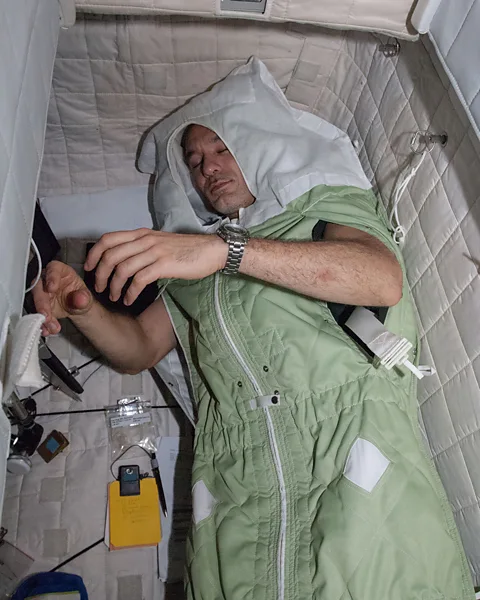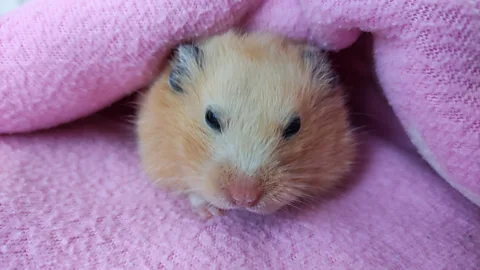Will we ever...hibernate in space?
 Getty Images
Getty ImagesTaking astronauts to Mars or further will take years. Should they be put into hibernation on the way? There are some surprising health benefits….
The year is 2039, and you're an astronaut on your way to Mars. You're only three months into the eight-month-long journey, and already your body is facing an onslaught of radiation from outer space. In zero gravity, your bones and muscles are at risk of wasting away.
You're not worried though, as you are about to enter your own private stasis booth. Cocooned inside, you'll blissfully sleep away the hours and days until you emerge fresh and rejuvenated at your destination.
For a long time a trope of science fiction stories, some scientists believe that human hibernation across the vastness of space could one day be possible.
If it were, it would be a boon for space exploration. A single astronaut consumes about 30kg (66lbs) of food and water a week. Multiply that by the approximate 16 months it would take to travel to Mars and back, and that adds up to a pretty hefty spaceship for all that life support.
Hibernating astronauts, on the other hand, wouldn't eat or drink much, and would consume minimal oxygen. Hibernation could therefore save mission controllers a huge amount of money, reducing the amount of food cargo needed by 75% and the size of spacecraft needed by up to one-third.
You might also like:
There's also the psychological factors to consider. Hibernating astronauts wouldn't get bored, stressed, or lonely, and less time and space would be needed to help keep them fit or entertained.
"There is uncertainty in how humans will react to the effect of no longer seeing Earth as a close-by planet out of the window, and seeing only dark outside," says Leopold Summerer, head of the European Space Agency's (Esa) Advanced Concepts Team, which keeps an eye on new space technologies. "The psychological stress this may induce is a bit of an unknown."
 Getty Images
Getty ImagesThere would also be health benefits to hibernation. Without the force of gravity, astronauts in space experience muscle wastage and bone density loss. Even at the International Space Station, where hi-tech gym equipment is available 24/7 and strict exercise protocols are followed, astronauts lose up to 20% of their muscle mass. Muscle wastage would be even more of a problem on missions to Mars, as there would be no support crews waiting by after a landing on the Red Planet.
Hibernation could protect against some of these risks. Hibernating animals enter a special state called a torpor, whereby their metabolism slows and their heart rate, breathing and body temperature fall. Even the cells that make up the animal's body stop dividing and dying. Torpor, which is different to sleep, allows animals to preserve energy at times of food scarcity. However, it also seems to protect against some of the harmful effects of space travel. For instance, squirrels have shown resistance to high levels of radiation while hibernating, possibly because hibernating cells replicate at much lower rates and are therefore naturally less susceptible to radiation damage.
Entering a torpor-like state also seems to help bears and squirrels preserve their bone structure and muscle tone. Despite hibernating for up to six months at a time, black bears emerge in spring with only marginal muscle loss, and are back to normal within 20 days. In fact, bears waking up from torpor show surprisingly high fitness levels.
"If you stayed in bed for several months you would lose a great deal of muscle tissue over that time," says Jüergen Bereiter-Hahn, a professor in neuroscience and cell biology at Goethe University in Frankfurt, Germany. Bereiter-Hahn is a member of the Esa's hibernation research group, which conducts research into human hibernation for long distance spaceflight to Mars.
"This strong reduction of tissue during long periods of disuse is almost completely avoided during torpor, which means astronauts coming to Mars should be in good shape and shouldn't need a very long time to recover."
 Nasa
NasaBears are also a good model for human hibernation because they only lower their body temperature by a few degrees, but still manage to reduce their metabolic rate considerably. Hibernating bears can also still function relatively normally during hibernation, with some females known to even wake up to give birth during this time.
But enough of the benefits. Is it possible? Well, maybe. Hibernating animals are distributed throughout the tree of life, including insects, amphibians, and many mammals. Studies have also shown that scientists can use drugs to induce a state of torpor in some animals such as rats that don't usually hibernate. The drugs act on a region of the brain called the hypothalamus, which is involved in regulating the body's temperature and heartbeat.
Cooling the body down could also initiate a kind of torpor-like state. In the 1990s, researchers from the Safar Center for Resuscitation Research at the University of Pittsburgh showed that rapidly cooling the circulatory system of dogs in cardiac arrest sent them into a state of suspended animation.
A similar process, known as therapeutic hypothermia, is already used in some hospitals to treat patients in cardiac arrest or with traumatic brain injuries. It's thought that cooling the body down to around 32-34C (89.6-93.2F) reduces damage to the brain and other vital organs. This makes sense, as the cells in our body require a constant supply of oxygen to meet their metabolic demands. Under normal circumstances, the heart pumps this oxygen around our body. But in trauma patients, the loss of blood causes cells to run out of oxygen and quickly die. Cooling the body down by a few degrees reduces the body's demand for energy and oxygen, buying physicians important time.
SpaceWorks Enterprises, an aerospace engineering based in Atlanta, Georgia, believes that therapeutic hypothermia could also be a good way of placing space travellers into a "synthetic torpor". The firm has received funding from Nasa to flesh out its idea, which would see astronauts placed in compact pods where they would enter a two-week stint of extended hibernation, before being active for a couple of days, and then going back into stasis again. This could be done on rotation, so that there would always be a member of the crew awake, addressing safety concerns or any emergencies that might occur.
 Getty Images
Getty Images"There are a number of different approaches to how you could cool someone down and lower their metabolism," says John Bradford, SpaceWorks CEO.
"In clinical settings they use intravenous cold saline injections that cool your body down and put ice packs on you, but that would be too invasive and not very practical for a spaceflight."
One option is to feed cooling nitrogen gas to astronauts via a nasal cannula. The gas would lower body temperature from 37.5C (99.5F) to around 32C (89.6F), which would cut metabolic activity by about 50%.
"We're also looking at other techniques such as using ambient air cooling to cool down the habitat, and then using a light sedative to relax the astronaut," says Bradford.
Robotic arms in the SpaceWorks module could then be programmed to move astronaut limbs, check body sensors, and administer electrical stimuli to astronauts' muscles to maintain tone. The astronauts would also receive bags of nutrients containing essential electrolytes, dextrose, lipids, and vitamins.
However, if we're going to realise the dream of human hibernation, it's vital that we gain more of an understanding of how the body and brain would initiate the process in the first place. Much of the work so far has focused on a neurotransmitter called adenosine, which acts on pathways in the hypothalamus that control sleep. A study in 2011 found that Arctic ground squirrels given drugs that activated adenosine receptors spontaneously entered torpor, as long as they were given the drug in winter.
Meanwhile, other studies suggest that a part of the brainstem called the raphe pallidus, which helps control automatic bodily processes, may be involved. Matteo Cerri at the University of Bologna, Italy, and his colleagues found that they could get rats and pigs – which do not normally hibernate – to enter a torpor-like state by inhibiting this region.
Summerer believes the mitochondria – a structure found in every living cell that converts chemicals in food into energy the body can use – may also play a role. His team is currently conducting experiments on the cells of hibernating Syrian hamsters to see if they have special adaptations that could help them cope with stressful environments.
 Getty Images
Getty ImagesTo create a stressful environment, cells from the hamster are put into a centrifuge and spun at high speeds. This subjects the cells to very strong gravitational forces, up to 20 times that of Earth. The results are then compared with cells from humans to see if there is any difference. Preliminary results show that increased G-forces damage the mitochondria in both human and hamster cells, but that hamster cells are able to somehow remove the damaged mitochondria, while human cells are not. However, more work is needed to calculate how statistically significant these differences are.
Whatever the case, teasing out the mechanisms involved will help us know if hibernation could be possible in humans – and whether we retain these dormant brain-signalling pathways.
"As far as we know, there is nothing unique about homo sapiens that would prevent our species from hibernating, and I believe the capacity is there but it needs to be unlocked," says Vladyslav Vyazovskiy, professor of sleep physiology at the University of Oxford.
"To me the real question is not whether we can hibernate, but how… How do neurons in the hypothalamus 'know' that it is time to hibernate? Who tells them? This is the real question."
--
